If you are a homeowner looking for ways to improve your home, the exterior of your house, and the patio beneath your feet, may be the best place to start. More often than not, homeowners tend to have an old patio, created with stone or concrete, that’s in desperate need of work, which could be easily redesigned into something different—something better.
One of the most common questions is whether or not you can build a deck over an old stone or concrete patio. The answer to this question is: yes. In fact, using deck tiles over concrete is not only a viable way to spruce up your outdoor living area but also a relatively easy project to undertake.
This is especially true if you use hardwood deck tile—Ipe deck tiles, in particular—which are incredibly durable, easy to assemble, and will look great just about anywhere.
Ipe has long been regarded as one of the best tropical hardwoods for all sorts of projects. Now, as more homeowners and contractors look to use high-quality, sustainable resources, Ipe lumber is becoming even more in demand.
If you’re looking for more reasons as to why you should use deck tiles over concrete, keep reading!
What is IPE?
Ipe, pronounced “ee-pay,” is a highly sought-after hardwood sourced from the forests of Central and South America. Known for its exceptional durability lasting up to 75 years, it is an ideal material for outdoor decking. Ipe has a rich brown color with fine grain patterns that may occasionally display a subtle reddish hue. Its dense cellular structure provides natural resistance to rot, decay, and insect infestation, while also ensuring remarkable toughness and longevity. This combination of resilience and beauty makes Ipe deck tiles a top choice for those seeking to enhance their outdoor living spaces.
First Things First: Can you Install Ipe Deck Tiles over Concrete?
Absolutely! You can install Lumber Plus Ipe deck tiles over concrete.
Lumber Plus Ipe deck tiles are resistant to rot, decay, and insect infestation, which makes them an excellent choice for both indoor and outdoor spaces.
In fact, to make the installation of deck tiles over concrete easy, efficient, and stylish, Lumber Plus has created two sizing options of Ipe deck tiles: 12×12 and 24×24—both of which have their own uses and installation methods:
12×12 Deck Tiles
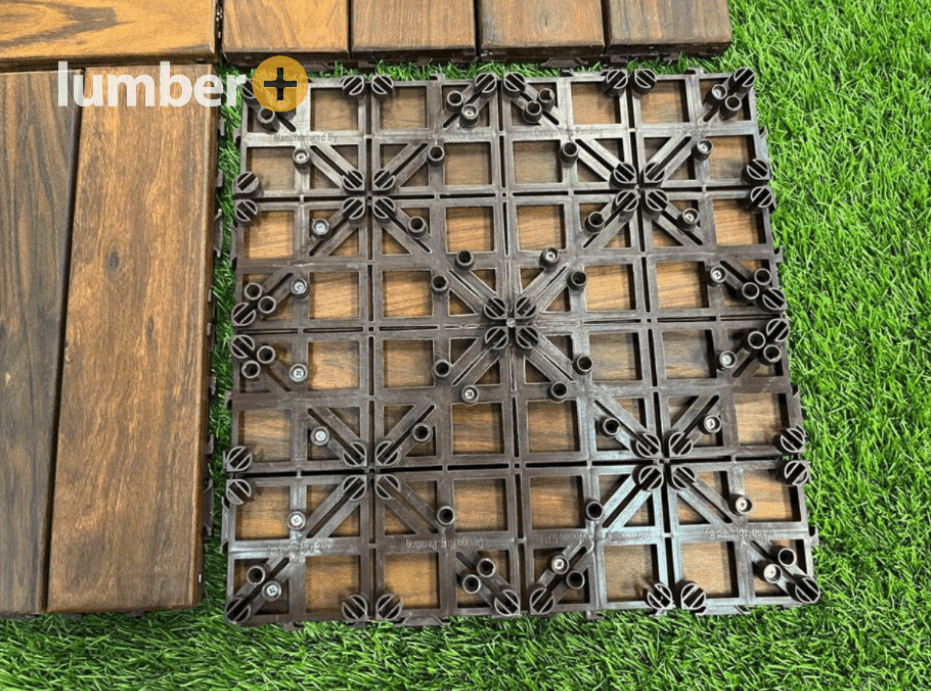
12×12 deck tiles should specifically be used for indoor projects or smaller patio, balcony, or rooftop surfaces. Because of their built-in interlocking connector, they are much easier and more efficient to install.
How to Install Ipe 12×12 Deck Tiles
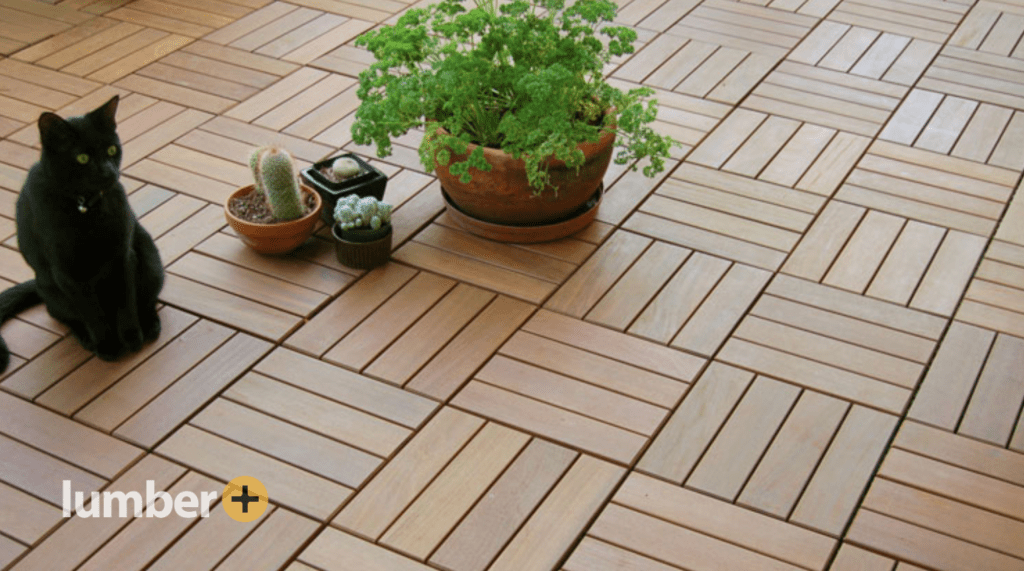
Whether you’re a DIY enthusiast or decking professional, 12×12 Ipe deck tiles are a perfect choice. With their pre-assembled interlocking design, you can lay them down right out of the box to fit neatly into your desired area. The tiles snap together effortlessly, which eliminates the need for custom fitting or specialized tools.
24×24 Deck Tiles
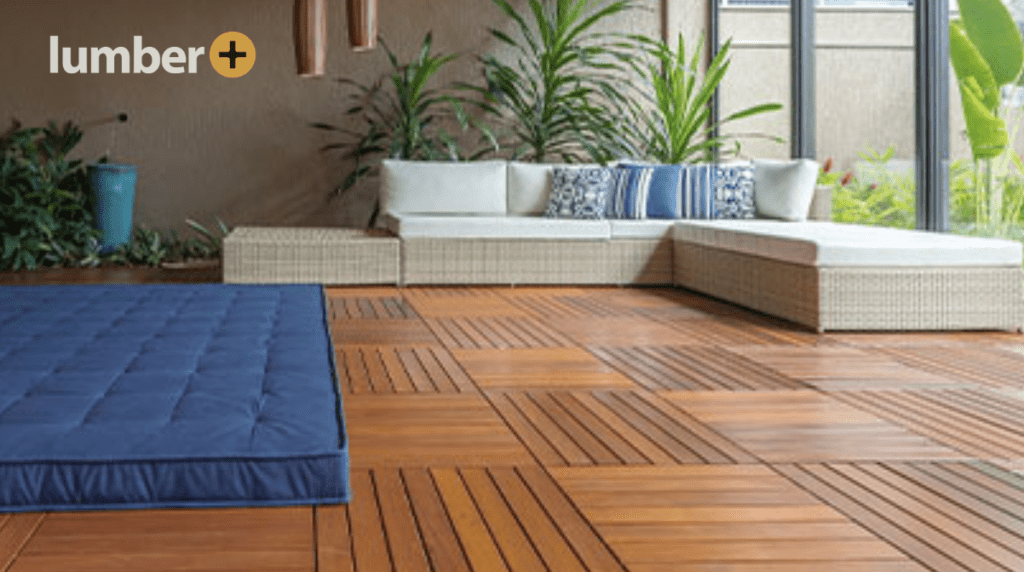
24×24 are most commonly used in larger outdoor projects—sometimes replacing a full deck entirely or other large concrete surfaces. They are also very common in larger buildings rooftops. For example, you may notice them in areas of multi-family facilities, such as pools, parks, restaurants, and entertainment venues.
How to Install Ipe 24×24 Deck Tiles
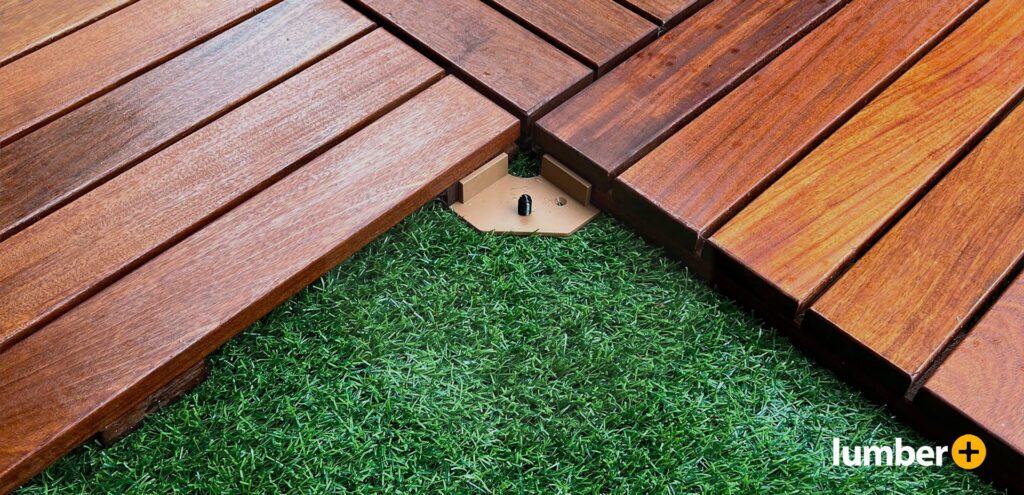
24×24 Ipe deck tiles are heavier and larger, so they don’t have the interlocking system that the 12×12 deck tiles have.
If using 24×24 deck tiles, quick connectors are essential for a secure installation to ensure that the tiles are evenly spaced and aligned, which not only enhances the visual appeal but also contributes to the longevity of your deck by providing stable support and facilitating drainage.
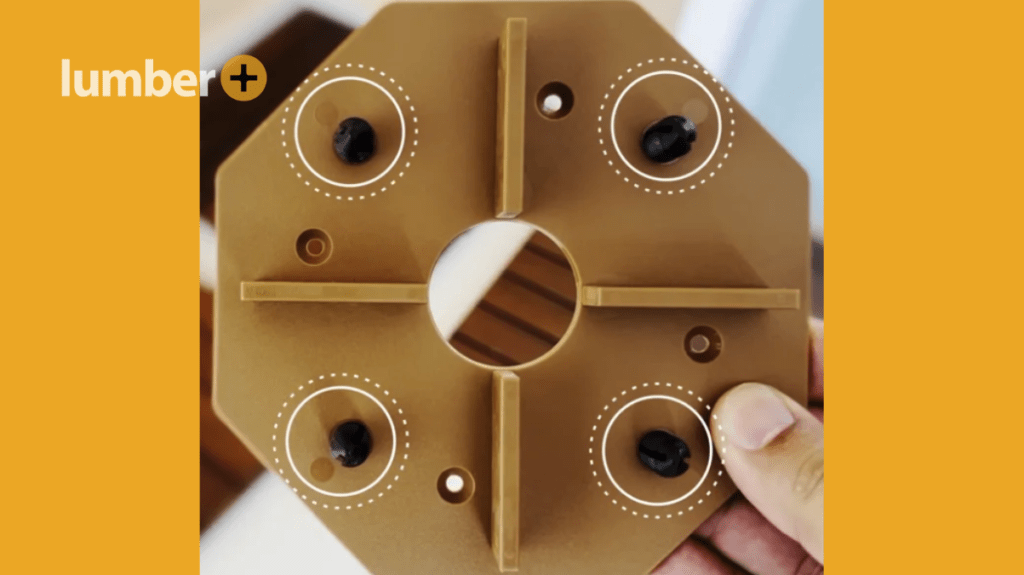
These connectors are easily installed by placing the tiles. You just lay the deck tiles onto the quick connectors, which snap onto the deck tile, connecting 4 tiles together. This simplifies the installation process, even with the dense and heavy Ipe wood.
5 reasons Why Installing Ipe Deck Tiles Over Concrete is a Good Idea
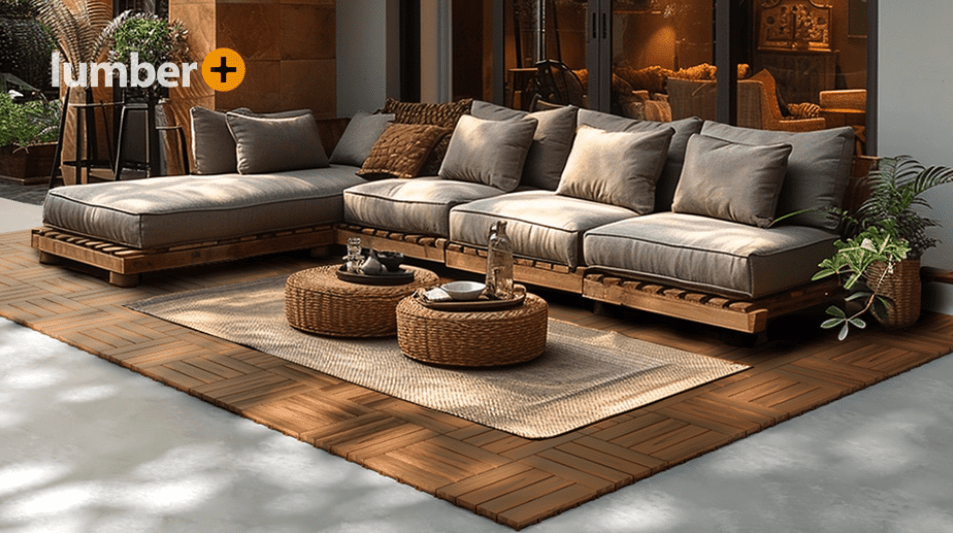
Here are some of the best reasons why you should consider using Ipe deck tiles over a concrete surface.
1. Flexibility and Adaptability
Deck tiles can be easily removed or replaced, which is a flexibility that traditional decks do not include. If a tile is damaged or if you wish to change the design, you can do so at a minimal cost compared to having to repair a larger board of a traditional hardwood deck.
While the upfront cost of Ipe deck tiles might be on par with or slightly higher than traditional decking materials, the overall cost savings when considering labor, tools, waste, maintenance, and long-term value can make them a more economical choice in the long run.
2. Quick Installation Options
Remember, to make installation even easier, Lumber Plus’s 12×12 Ipe deck tiles have a built-in interlocking system to easily snap into place, whereas 24×24 deck tiles can be used with quick connectors for faster and more efficient setup. These connectors fit underneath the tiles to keep them secure without being visible in order to retain the deck’s aesthetic.
They not only ensure a sturdy connection between tiles, they also promote proper drainage that is crucial for maintaining the longevity and appearance of your outdoor flooring.
3. Long-lasting and Sturdy
Ipe is an incredibly durable hardwood for outdoor decking. Its intrinsic hardness and resistance to external elements make it one of the toughest options available. With the ability to withstand physical damage and various weather conditions, an Ipe deck can last for 50 years or more. This long lifespan not only reduces maintenance and replacement costs, it also adds value to your home by providing a lasting aesthetic and functional upgrade.
4. Practical Solution
Choosing Ipe deck tiles is a practical way to revitalize existing concrete surfaces without demolition. This method is ideal for patios and locations where removing concrete is impractical, like rooftop patios. By overlaying wooden deck tiles, you can improve the usability and appearance of your space without eliminating the underlying concrete foundation. It’s a perfect blend of functionality and style.
5. Looks Great
Ipe deck tiles not only offer practical benefits, they also enhance the aesthetic appeal of any outdoor area. The rich tones and unique grain patterns of Ipe wood bring natural beauty and warmth to your space to instantly transform plain concrete into a striking outdoor feature. Moreover, Ipe wood requires minimal upkeep to maintain its appearance and help ensure that your space remains inviting and stylish for years to come.
Helpful Tools for Installing Deck Tiles Over Concrete
One of the best parts about installing deck tiles over concrete is that there are no specialized tools required that you would otherwise have to spend money on. However, there are some tools that may make installing the deck tiles over concrete a bit easier:
Rubber Mallet
Though not always needed, a rubber mallet could be helpful when gently tapping deck tiles into place on the connectors. It is easily preferred over a hammer, which could help you avoid damaging the wood’s surface.
Tape Measure and Chalk Line
Precision is key in laying out tiles. A tape measure will help to accurately plan your layout, while a chalk line can be used to mark guidelines on the concrete to help ensure straight and symmetrical installation patterns.
Additional Considerations:
End Seal and Oil (Optional but Recommended)
After cutting any Ipe tiles, it’s crucial to apply an end seal to the cut ends to prevent splitting or cracking due to moisture. Oiling the tiles can enhance their natural color and provide an additional layer of protection against the elements. Choose products specifically designed for Ipe wood to ensure compatibility.
By understanding the purpose and proper use of each material and tool, you can ensure a smoother installation process and achieve a beautiful, long-lasting Ipe deck over your concrete surface. Remember, the quality of your materials and tools can significantly impact the final outcome, so choose wisely and don’t hesitate to seek professional advice if you’re unsure about the best options for your project.
2 Tips for Installing Deck Tiles Over Concrete
If you have decided to install wood deck tiles over concrete, there are a few tips that may be useful.
Tip 1: Clean the Concrete Patio
You should clean the area where you will be installing deck tiles over concrete. This ensures that nothing beneath the tiles interferes with the deck tile laying process.
Remove any debris and make sure the concrete is clean and smooth. And remember, there is no need to replace old concrete. You are just going to cover it with new Ipe deck tiles.
Tip 2: Properly Measure the Concrete Space Ipe Deck Tile Placement
Once the area is cleaned, another good tip to remember is that you should measure the space of concrete that you are looking to cover. This will make sure you are able to place your pre-built deck tiles properly, that is, so they fit the space you’re looking to cover.
Instead of inaccurately dropping deck tiles down on the concrete, make sure all your deck tiles fit the space and cover the concrete. Doing this will help ensure you do not have any bottom layer of concrete showing and help you save resources so you don’t have a large quantity of deck tiles left over.
Then, once you do this, all you have to do is make your tiles fit the space and enjoy the quality experience of walking on your new deck tiles.
There are many types of wood deck tiles, but Ipe wood deck tiles are the best to use. Although they are a bit heavier than over hardwoods and thus more difficult to work with, the labor involved in assembling your deck tiles is manageable, can be done in one day, and is well worth the effort.
Cost Analysis
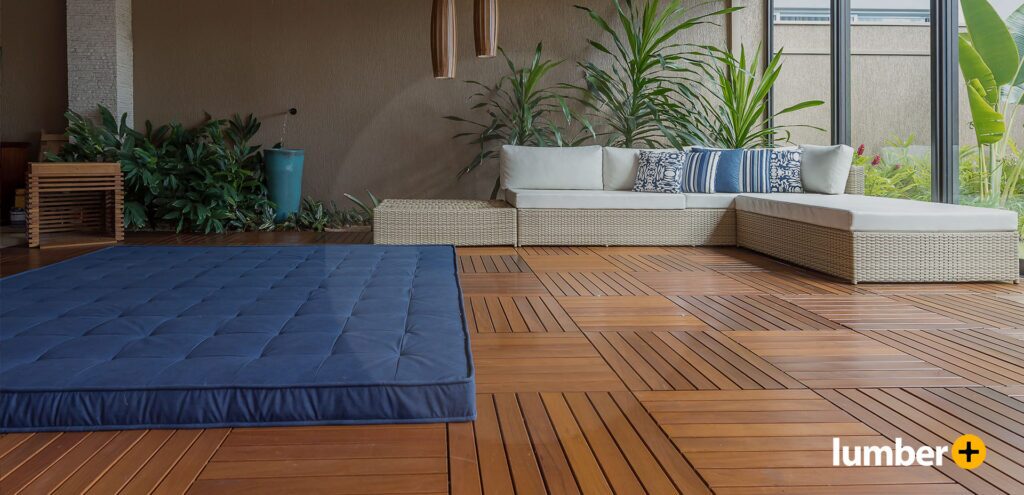
Using deck tiles over concrete can provide several cost advantages, especially when it’s compared with replacing old concrete.
Here are the key financial benefits of choosing deck tiles:
Less Required Materials
When concrete becomes cracked, damaged, or unappealing, it can require a large amount of heavy cement to replace it. In fact, you won’t just need the bags of concrete. You will also need a shovel, wheelbarrow, bucket, concrete hoe, or even gloves to effectively replace it
However, when you use Ipe deck tiles over concrete, you will only need the deck tiles and, possibly, connectors depending on the size you choose. In other words, you can save yourself both time and money when choosing to install the deck tile over concrete rather than replacing the concrete itself. (Not to mention, it will look a lot better than a large, dull, gray and textureless surface.)
Reduced Labor
Compared to replacing the older concrete, installing deck tiles also requires significantly less labor—eliminating the need for extensive foundation work and concrete mixing. This makes installing them much easier, and a professional who works with deck tiles can help you install deck tiles over concerts more effectively. That way, you can spend less time watching concrete pour more time enjoying your new glistening deck surface.
Minimal Waste
Deck tiles are designed to fit together seamlessly, which results in minimal to no waste during the installation process. Not to mention, if you measure your concrete space correctly or work with a professional installer, you will not have any additional tiles leftover—or very few, if any.
When you replace the concrete with new concrete, however, you will more likely than not have extra resources leftover and, unfortunately, left to waste.
Longevity and Maintenance
Similar to concrete, the durability of Ipe deck tiles means they can last for decades.
However, unlike concrete, if a specific deck tile is damaged, you can easily replace it. Whereas concrete can require a complete resurfacing, you can easily replace deck tiles by disconnecting it and moving it somewhere else that is hardly seen—or even better—replacing it with a new deck tile that will look brand new, match the others, and last just as long.
Maintenance and Care For Deck Tiles
Ipe deck tiles require minimal upkeep. An annual sealing is typically all that’s needed to maintain their beauty and resilience against the elements.
Step Into a New Era of Outdoor Elegance with Lumber Plus
With Lumber Plus premium Ipe deck tiles, transforming your outdoor living space has never been easier. Our top-quality materials guarantee a stunning, durable deck over your existing concrete surface.
Contact us today for more information! natural lifecycle.






